

 |
Search the Site with

|
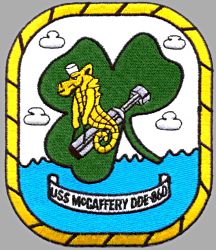 | 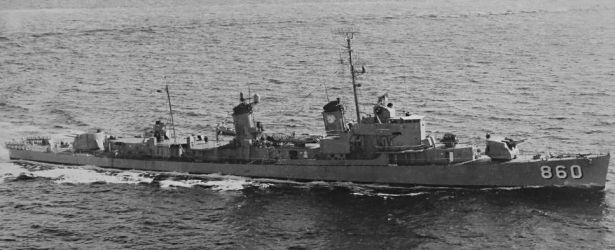 USS McCAFFERY in her DDE configuration | 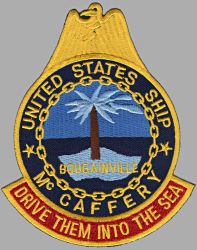 |
USS McCAFFERY was one of the GEARING - class destroyers and the first ship in the Navy to bear the name. Converted to an escort destroyer, she was redesignated DDE 860 on April 1, 1950. On June 30, 1962, McCAFFERY was reclassified as destroyer DD 860 again. Decommissioned on September 30, 1973, the McCAFFERY was sold for scrapping on June 11, 1974.
| General Characteristics: | Awarded: 1943 |
| Keel laid: October 1, 1944 | |
| Launched: April 12, 1945 | |
| Commissioned: July 26, 1945 | |
| Decommissioned: September 30, 1973 | |
| Builder: Bethlehem Steel, San Pedro, Calif. | |
| FRAM II Conversion Shipyard: New York Naval Shipyard, Brooklyn, NY | |
| FRAM II Conversion Period: 1961 - November 1961 | |
| Propulsion system: four boilers, General Electric geared turbines; 60,000 SHP | |
| Propellers: two | |
| Length: 391 feet (119.2 meters) | |
| Beam: 41 feet (12.5 meters) | |
| Draft: 18.7 feet (5.7 meters) | |
| Displacement: approx. 3,400 tons full load | |
| Speed: 34 knots | |
| Aircraft after FRAM II: two DASH drones | |
| Armament after FRAM II: two 5-inch/38 caliber twin mounts, Mk-32 ASW torpedo tubes (two triple mounts), one Hedgehog Mk-15 | |
| Crew after FRAM II: 14 officers, 260 enlisted |
Crew List:
This section contains the names of sailors who served aboard USS McCAFFERY. It is no official listing but contains the names of sailors who submitted their information.
USS McCAFFERY Cruise Books:
USS McCAFFERY History:
McCAFFERY was laid down 10 October 1944 by Bethlehem Steel Co., Shipbuilding Division, San Pedro, Calif.; launched 4 April 1945; sponsored by Miss Patricia McCaffery, niece of Lt. Col. Joseph P. McCaffery; and commissioned 26 July 1945, Comdr. Benjamin B. Cheatham, USN, in command.
Following a west coast fitting out and shakedown period, McCAFFERY departed 8 October 1945 for Hawaii and further training. On 24 January 1946, she got underway for the western Pacific, stopping at Guam to take on $6 million for NavGroupChina at Shanghai. She arrived at the mouth of the Yangtze River 9 February, delivered her cargo, and sailed on to Tsingtao the next day. From there she conducted escort duties and operational training in the China and Japanese Seas until she headed home at the end of January 1947, arriving San Francisco 20 February. Until December, when she again departed for the western Pacific, McCAFFERY operated on the west coast.
By 1 February 1948 the destroyer was again operating off Tsingtao, rescuing on that date 18 survivors of the stricken Chinese merchantman MING SING. For the next 5 months she trained and performed search and rescue operations in the waters between Okinawa and the Chinese mainland.
On 2 January 1949, McCAFFERY entered Mare Island Naval Shipyard for conversion to escort destroyer (DDE). Her alterations completed, she sailed 25 August for duty with the Atlantic Fleet, reporting 11 September at Newport, R.I. She officially acquired the designation DDE 860 1 April 1950 while participating in ASW operations. In July she sailed for the Mediterranean with CortDiv 61. By the time she reached Phaleron Bay, Greece, her orders had been changed and she proceeded on to the Far East with the light cruiser WORCESTER (CL 144).
McCAFFERY arrived at Okinawa 19 August. From there she headed for Taiwan where, through October, she operated with the Formosa Strait patrol. On 7 November she rendezvoused with the fast carrier force TF 77 in the Sea of Japan off the coast of Korea. With that force for the next 3 months, she performed plane guard and screening duties as its planes raided enemy troop concentrations and transport and communication networks.
The destroyer returned to Newport 14 March 1951 and for the next 7 years operated alternately with the 2d and 6th Fleets. Primarily engaged in hunter-killer exercises, she completed five cruises to the Mediterranean, one to northern Europe for NATO exercises and one to South America for 3 months of training with Venezuelan, Brazilian, Uruguayan, and Argentine naval units.
In November 1958, McCAFFERY joined Task Group Bravo, a permanent hunter-killer group, composed of a CVS, a destroyer squadron, and various aircraft and helicopter squadrons whose operations helped to develop ASW carrier group tactics and equipment. During the next 2 1/2 years her "TGB" operations, ranging from Newfoundland to the Caribbean, were interrupted by two midshipmen summer cruises, to Bermuda in 1959 and the Mediterranean in 1960, and a brief tour as DesLant engineering schoolship, fall 1960. In 1961, following an unsuccessful attempt to rescue personnel from TEXAS TOWER NO. 4, and spring operations in the Caribbean, she underwent a 7-month FRAM overhaul at New York. Alterations made then included the addition of equipment for the Drone Antisubmarine Helicopter.
Overhaul completed, McCAFFERY began 1962 steaming to her new home port of Mayport, Fla. She was reclassified DD 860 on 30 June 1962. She participated in refresher training out of Guantanamo Bay, Cuba, before getting underway for a 6-month Mediterranean deployment, 18 April. She returned from 6th Fleet duty 2 October, only to depart Mayport 3 weeks later to join other Atlantic Fleet units in maintaining the quarantine imposed on Cuba during the missile crisis.
During the next 3 years, McCAFFERY, in addition to operational training along the east coast and in the Caribbean, acted as communications relay ship for the Mercury space shot, May 1963; provided services to the Fleet Sonar School at Key West; and completed three oversea deployments. Her 1963 deployment took her to the Mediterranean for AAW/ASW training with Greek, Turkish, and British forces; 1964, to northern Europe on a midshipmen summer cruise; and 1965, to the Red Sea and Persian Gulf for CENTO operations with British and Iranian ships.
McCAFFERY spent all of 1966 in the western Atlantic, participating in two space project recovery missions, Gemini IX and XII, and Fleet Sonar School training before undergoing intense type training and fire support exercises in preparation for 7th Fleet deployment. On 7 February 1967, McCAFFERY departed Mayport for duty in the western Pacific. From her arrival off the coast of Vietnam, 24 March, until her departure, 1 August, she performed all the duties expected of a destroyer. She provided naval gunfire support along the coast of South Vietnam, acted as plane guard and screen for ENTERPRISE (CVAN 65), participated in "Sea Dragon" operations off the North Vietnamese coast, and performed antisubmarine patrols in the Gulf of Tonkin. After returning to Mayport 11 September, McCAFFERY resumed operations with the 2d Fleet, remaining on the east coast into 1969.
McCAFFERY received two battle stars for Korean service.
About the Ship's Name:
Lt. Col. Joseph P. McCaffery, USMC, born 20 August 1906 in Chester, Pa., accepted a commission in the Marine Corp Reserve in March 1929, after resigning a commission in the Army Reserve held from 1927. A veteran of action at Guadalcanal and New Georgia, he was fatally wounded at Cape Torokina, Bougainville, 1 November 1943, as he led his Marine Raider battalion against entrenched Japanese positions. For his valiant and inspiring leadership he was posthumously awarded the Navy Cross.
USS McCAFFERY Image Gallery:
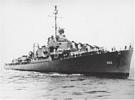 | 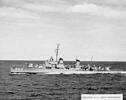 | 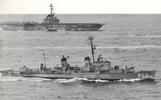 |
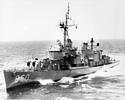 | 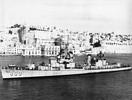 |
 Back to Destroyers list.
Back to Destroyers list.  Back to ships list.
Back to ships list.  Back to selection page.
Back to selection page.  Back to 1st page.
Back to 1st page.